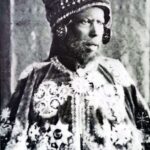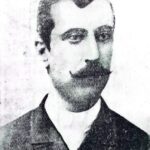MUNGEMBE
- 6 Min Read
Mungembe (circa 1870-1949) worked as an agent of the Belgian colonial power to bring government control and administrative order to the politically decentralised peoples living in the Giri river region, east and north of modern Makanza (located 200 km or 120 mi north of Mbandaka on the Zaire River). Although a member of the Libinza people who are settled on the Giri east of Makanza, Mungembe traveled up and down the river aiding European officials in their task of pacification and administration.
Mungembe was born at Molanga, a village on the left bank of the Giri, in about 1870. Because his father died while he was still small, the youth was raised by his father’s maternal uncles, who had paid his mother’s dowry. Mungembe grew up in his uncle’s village of Bosilela, about 200 km (120 mi) north of Mbandaka, where he became a close friend of two other young men, Nzamba and Molonga. The three earned a reputation as good warriors.
On August 21, 1897, Lt. Wilvert became the first European to reach Giri by way of the Mabale stream, which cut across the marshy land from Nouvelle-Anvers (now Makanza). Late in 1897 the Bosilela elder Matabakemba, hoping to protect the Libinza from the aggressive Likoka people west of the Giri who were terrorising the region, approached Wilvert asking him to establish a station at Bosilela. Thus, in 1898, the Europeans from Nouvelle-Anvers founded a post at Bosilela, which they called Bosesera.
Matabakema was recognised by the whites as chief of Bosilela as well as of all the Libinza people. When he died, not long afterwards, his son refused to succeed him as an agent of the Congo Free State. Thus, Sommelier, or Limpanya as he was called by the Africans, who was head of the post at Bosilela, selected Nzamba, Mungembe’s close friend, as the next chief. Thus, Nzamba, Mungembe, and Molonga joined the Force Publique (colonial army) and worked to conquer the countryside for the Europeans and the Libinza. Sommelier and his African allies were successful because their guns demoralised the warriors of the other peoples of the interior. The once-dangerous Likoka, especially affected by these events observed wryly that: “The Bansongo [the Likoka name for the Libinza] whom we once captured, almost without using weapons, have become strong because of their rifles.” Small village communities, formerly independent, came under the authority of Sommelier and “chief” Nzamba. The bloody campaign, which lasted for nearly three years, resulted in the death of many Giri people. The Ndobo, who live just south of the Libinza, were especially hard hit.
As the whites extended the area they controlled along the Giri River, they decided to divide the administrative tasks among Nzamba and his two associates. Nzamba retained his authority over the Libinza, the Mbonzi, and Likoka; Molonga was dispatched north to Monya, where he was placed in charge of the Mwe people; while Mungembe went even further north to the Mwe and Ngbandi of the upper Giri region. Not long afterwards Mungembe was transferred to Bonyange on the Moanda River, where he governed the Biwaku. In the absence of close supervision from the Free State officials, Nzamba, Molonga, and Mungembe gathered groups of Libinza men armed with rifles and subdued the peoples living along the Giri River. As they worked to create large fiefdoms for themselves they captured hundreds of slaves, especially women, and took booty from the villagers.
In 1906, Nzamba was arrested for his many atrocities and exiled to Boma near the mouth of what is now the Zaire River. Since Molonga wished to remain in the more isolated upper Giri region, Mungembe was selected as chief of Bosesera. In 1911, colonial officials asked that Mungembe relocate to Bolongo, west of the Giri. Then, in 1914, Molonga was driven out of Monia in the north by the people he had been exploiting. When he returned to his home area among the Libinza, Mungembe’s domain was divided into two parts: the northern section given to Molonga, while the southern part still remained in Mungembe’s hands. Six years later, in 1920, Molonga again had to flee from the people he ruled. Finally, in 1922 he committed suicide in order to escape arrest and exile. Mungembe, too, faced unrest and discontent on the part of his African subjects. From 1922 to 1925, supported by Salomon Mohila, a literate former soldier who was chief of the Mosubi people, the Bokwala and Wambala areas of Mungembe’s chiefdom tried to oust their ruler.
Mungembe was able to retain his post only because he received strong support from the Europeans. But in 1925 Mungembe was made a subordinate chief in a newly formed Libinza sector, headed by Mohila. Although Mohila and Mungembe had been rivals, Mungembe worked as his former enemy’s loyal subordinate. Gradually, Mungembe’s village and the populations he governed became relatively unimportant. The sleeping sickness epidemics of the 1920s and 1930s seriously depleted the number of people in Mungembe’s territory, and even greater cause of population decline was the substantial out-migration from the Giri area to the growing Congo River towns of Lokolela, Irebu, Coquilhatville, and Lolanga.
As early as 1913, Libinza people had left the area to earn a better living elsewhere and to escape harassment from local officials. Individuals who remained around the Giri were forced to pay taxes, cut wood for the small steamers plying the river as far north as the confluence of the Giri and Moanda, maintain the channels linking the Congo and Giri rivers, supply provisions for the government post at Bomana, 160 km (100 mi) north of Mbandaka, and search for copal. Because Mungembe could not halt the flow of people from his land, he was frequently accused of incompetence or of encouraging his subjects to leave. As a chief serving the colonial power, Mungembe grew wealthy. Through various means, he acquired about 100 wives. Since he sometimes shared these women with European visitors, some of Mungembe’s children were mulatto.
Mungembe also gained many slaves, taken primarily from the upper Giri area. Some were resold to the Likoka people, others served Mungembe, continuing to work for him even after they were officially freed by the government. When Mungembe died in 1949, his grandson, Ebamba Moboko Moi-Molanga, succeeded him. Ebamba ruled at Bosesera until 1950, when he became chief of the entire Libinza sector.
MUMBANZA BAWELE
NYABAKOMBI ENSOBATO




